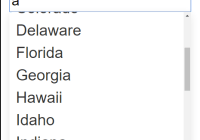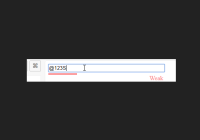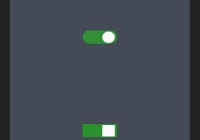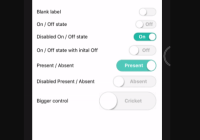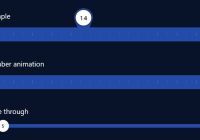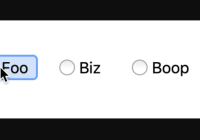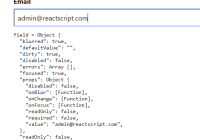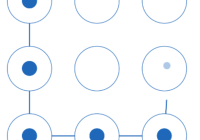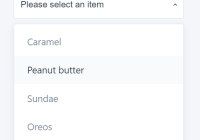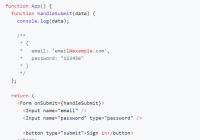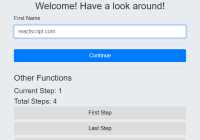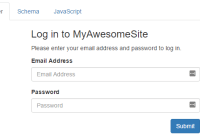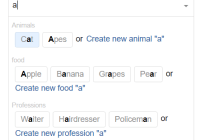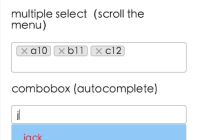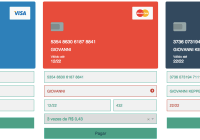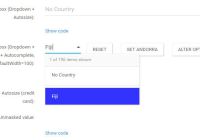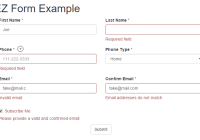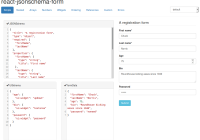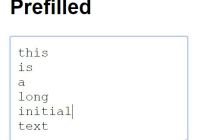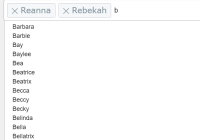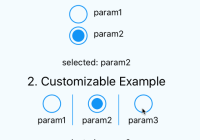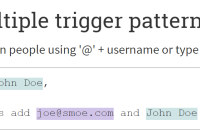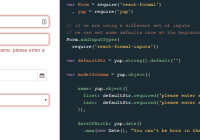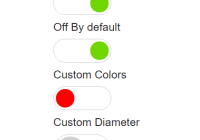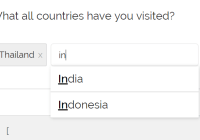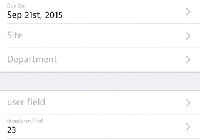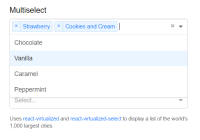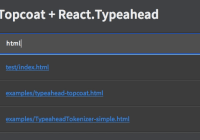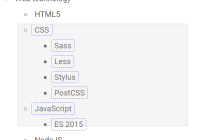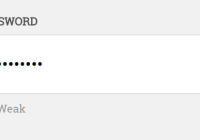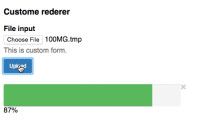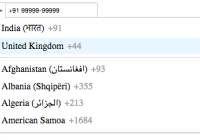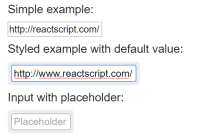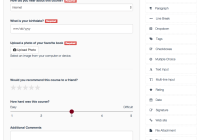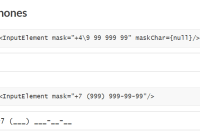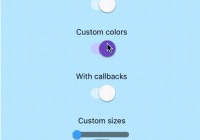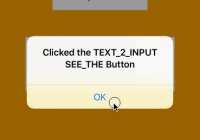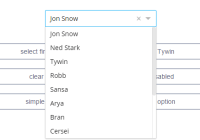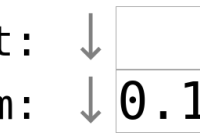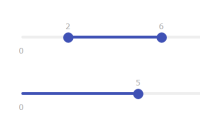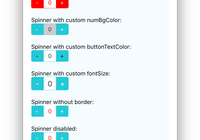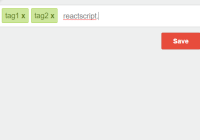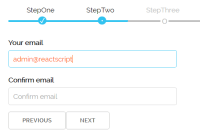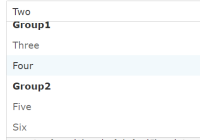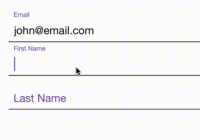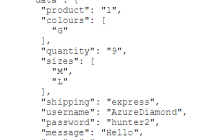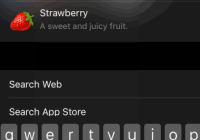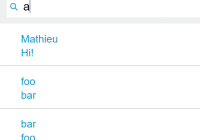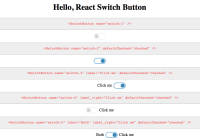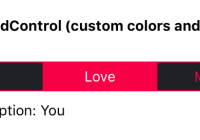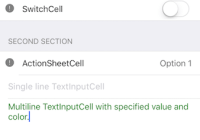React Autocomplete 
Accessible, extensible, Autocomplete for React.js.
<Autocomplete getItemValue={(item) => item.label} items={[ { label: 'apple' }, { label: 'banana' }, { label: 'pear' } ]} renderItem={(item, isHighlighted) => <div style={{ background: isHighlighted ? 'lightgray' : 'white' }}> {item.label} </div> } value={value} onChange={(e) => value = e.target.value} onSelect={(val) => value = val} />Check out more examples and get stuck right in with the online editor.
Install
npm
npm install --save react-autocompleteyarn
yarn add react-autocompleteAMD/UMD
- Development: https://unpkg.com/[email protected]/dist/react-autocomplete.js
- Production: https://unpkg.com/[email protected]/dist/react-autocomplete.min.js
API
Props
getItemValue: Function
Arguments: item: Any
Used to read the display value from each entry in items.
items: Array
The items to display in the dropdown menu
renderItem: Function
Arguments: item: Any, isHighlighted: Boolean, styles: Object
Invoked for each entry in items that also passes shouldItemRender to generate the render tree for each item in the dropdown menu. styles is an optional set of styles that can be applied to improve the look/feel of the items in the dropdown menu.
autoHighlight: Boolean (optional)
Default value: true
Whether or not to automatically highlight the top match in the dropdown menu.
inputProps: Object (optional)
Default value: {}
Props passed to props.renderInput. By default these props will be applied to the <input /> element rendered by Autocomplete, unless you have specified a custom value for props.renderInput. Any properties supported by HTMLInputElement can be specified, apart from the following which are set by Autocomplete: value, autoComplete, role, aria-autocomplete. inputProps is commonly used for (but not limited to) placeholder, event handlers (onFocus, onBlur, etc.), autoFocus, etc..
isItemSelectable: Function (optional)
Default value: function() { return true }
Arguments: item: Any
Invoked when attempting to select an item. The return value is used to determine whether the item should be selectable or not. By default all items are selectable.
menuStyle: Object (optional)
Default value:
{ borderRadius: '3px', boxShadow: '0 2px 12px rgba(0, 0, 0, 0.1)', background: 'rgba(255, 255, 255, 0.9)', padding: '2px 0', fontSize: '90%', position: 'fixed', overflow: 'auto', maxHeight: '50%', // TODO: don't cheat, let it flow to the bottom }Styles that are applied to the dropdown menu in the default renderMenu implementation. If you override renderMenu and you want to use menuStyle you must manually apply them (this.props.menuStyle).
onChange: Function (optional)
Default value: function() {}
Arguments: event: Event, value: String
Invoked every time the user changes the input's value.
onMenuVisibilityChange: Function (optional)
Default value: function() {}
Arguments: isOpen: Boolean
Invoked every time the dropdown menu's visibility changes (i.e. every time it is displayed/hidden).
onSelect: Function (optional)
Default value: function() {}
Arguments: value: String, item: Any
Invoked when the user selects an item from the dropdown menu.
open: Boolean (optional)
Used to override the internal logic which displays/hides the dropdown menu. This is useful if you want to force a certain state based on your UX/business logic. Use it together with onMenuVisibilityChange for fine-grained control over the dropdown menu dynamics.
renderInput: Function (optional)
Default value:
function(props) { return <input {...props} /> }Arguments: props: Object
Invoked to generate the input element. The props argument is the result of merging props.inputProps with a selection of props that are required both for functionality and accessibility. At the very least you need to apply props.ref and all props.on<event> event handlers. Failing to do this will cause Autocomplete to behave unexpectedly.
renderMenu: Function (optional)
Default value:
function(items, value, style) { return <div style={{ ...style, ...this.menuStyle }} children={items}/> }Arguments: items: Array<Any>, value: String, styles: Object
Invoked to generate the render tree for the dropdown menu. Ensure the returned tree includes every entry in items or else the highlight order and keyboard navigation logic will break. styles will contain { top, left, minWidth } which are the coordinates of the top-left corner and the width of the dropdown menu.
selectOnBlur: Boolean (optional)
Default value: false
Whether or not to automatically select the highlighted item when the <input> loses focus.
shouldItemRender: Function (optional)
Arguments: item: Any, value: String
Invoked for each entry in items and its return value is used to determine whether or not it should be displayed in the dropdown menu. By default all items are always rendered.
sortItems: Function (optional)
Arguments: itemA: Any, itemB: Any, value: String
The function which is used to sort items before display.
value: Any (optional)
Default value: ''
The value to display in the input field
wrapperProps: Object (optional)
Default value: {}
Props that are applied to the element which wraps the <input /> and dropdown menu elements rendered by Autocomplete.
wrapperStyle: Object (optional)
Default value:
{ display: 'inline-block' }This is a shorthand for wrapperProps={{ style: <your styles> }}. Note that wrapperStyle is applied before wrapperProps, so the latter will win if it contains a style entry.
Imperative API
In addition to the props there is an API available on the mounted element which is similar to that of HTMLInputElement. In other words: you can access most of the common <input> methods directly on an Autocomplete instance. An example:
class MyComponent extends Component { componentDidMount() { // Focus the input and select "world" this.input.focus() this.input.setSelectionRange(6, 11) } render() { return ( <Autocomplete ref={el => this.input = el} value="hello world" ... /> ) } }Development
You can start a local development environment with npm start. This command starts a static file server on localhost:8080 which serves the examples in examples/. Hot-reload mechanisms are in place which means you don't have to refresh the page or restart the build for changes to take effect.
Tests!
Run them: npm test
Write them: lib/__tests__/Autocomplete-test.js
Check your work: npm run coverage
Scripts
Run with npm run <script>.
gh-pages
Builds the examples and assembles a commit which is pushed to origin/gh-pages, then cleans up your working directory. Note: This script will git checkout master before building.
release
Takes the same argument as npm publish, i.e. [major|minor|patch|x.x.x], then tags a new version, publishes, and pushes the version commit and tag to origin/master. Usage: npm run release -- [major|minor|patch|x.x.x]. Remember to update the CHANGELOG before releasing!
build
Runs the build scripts detailed below.
build:component
Transpiles the source in lib/ and outputs it to build/, as well as creating a UMD bundle in dist/.
build:examples
Creates bundles for each of the examples, which is used for pushing to origin/gh-pages.
test
Runs the test scripts detailed below.
test:lint
Runs eslint on the source.
test:jest
Runs the unit tests with jest.
coverage
Runs the unit tests and creates a code coverage report.
start
Builds all the examples and starts a static file server on localhost:8080. Any changes made to lib/Autocomplete.js and the examples are automatically compiled and transmitted to the browser, i.e. there's no need to refresh the page or restart the build during development. This script is the perfect companion when making changes to this repo, since you can use the examples as a test-bed for development.
